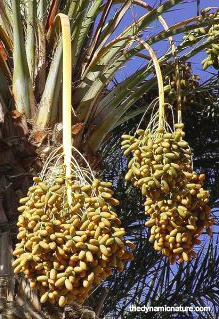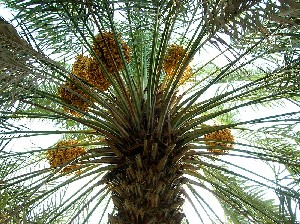Date palm fruits
Date palm (Phoenix dactylifera), a monocotyledon, belongs to the family Palmae and the genus Phoenix. Dates have been included as a staple food in Middle East Asia and North East Africa for thousands of years.The palm is dioecious, male and female palms being separate.
The fruit is a berry and depending upon the variety and maturity, comes in colors like bright yellow, bright red and deep blackish red.
On pollination a female flower takes about 200 days to ripen into a berry.
The berries can be consumed both before and after drying. They can also be made into syrups and chopped to make a number of sweet dishes.
Nutrients
Date fruit has high nutritional value and is high in sugar comprising up to 70% by weight.Glucose and fructose are the main constituents of the sugar. They are poor in proteins [up to 3%].
The fruit is very rich in essential minerals. It is a good source of potassium, iron and calcium.
It also contains fair amount of chlorine, magnesium, copper, phosphorus and sulfur.
Dates are good sources of A and B vitamins. Dietary fiber makes up to 5% of the fruit.
Antioxidants
Tannins which are polyphenol antioxidants constitute about 3% the dry weight of the dates. These tannins give the brown color to them.They also help in the removal of free-radicals, thereby giving immunity to our body and protection from free-radical caused diseases.
Constipation
The fairly high fiber content gives relief from constipation. These dietary fibers help in digestion, assimilation and evacuation. The fruit also functions as a laxative.
Pregnancy
It is experimentally found that dates contain certain stimulants which help in strengthening the contractile muscles of uterine wall in last term of the pregnancy.Dates help in the dilation of the uterus and smooth delivery of the infant with reduced bleeding.
Date, because of its high iron content, is recommended for pregnant women and nursing mothers.
The seed powder of dates is used in traditional medicines. The desert population which is dependant on dates as food is found to have less cancer diseases.
|
| |||
|
| |||
|
| |||
|
| |||
|
| |||
|
| |||
|
| |||
|
| |||
|
| |||
The dynamic nature
Mahmood Syed Faheem

| Underweight | :below 18.5 |
| Normalweight | :18.5-24.9 |
| Overweight | :25-29.9 |
| Obesity | :above 30.0 |
Advertisement